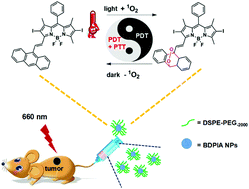An anthracene functionalized BODIPY derivative with singlet oxygen storage ability for photothermal and continuous photodynamic synergistic therapy†
Abstract
Singlet oxygen (1O2) generated from the photosensitization process within tumor tissues during photodynamic therapy (PDT) is self-limiting. Fractional delivery of light tends to be a better method for PDT. Herein, BDPIA with a high 1O2 quantum yield (QY) of 70% in DCM has an additional anthracene module for capturing 1O2, which would be useful in PDT. In the light cycle, the endoperoxide of anthracene is generated with singlet oxygen while in the dark cycle, the endoperoxide undergoes thermal cycloreversion to produce 1O2, regenerating the anthracene module. Therefore, the photodynamic process can continue in the dark period and the light cycles, promising their continuous phototherapy efficacy. In addition, BDPIA NPs in water exhibit a high photothermal conversion efficiency (η = 38.9%) for effective photothermal therapy. In vitro MTT assay shows that BDPIA NPs have a low half inhibitory concentration (IC50) of 6.293 μg mL−1 on HeLa cells. Furthermore, lentiviral vector transfected HeLa cell lines with red fluorescent proteins were used to perform real time in vivo fluorescence imaging guided phototherapy. The model can monitor the real-time uptake of BDPIA NPs. The results indicate that BDPIA NPs are capable of inhibiting cell proliferation even at a low dosage (0.2 mg kg−1) while the normal tissues (heart, liver, spleen, lung and kidney) suffer from no side effects. Our results demonstrate that BDPIA NPs with high phototoxicity, low dark toxicity and excellent bio-compatibility can be used as a potential photosensitizer for continuous photodynamic and photothermal synergistic therapy.



 Please wait while we load your content...
Please wait while we load your content...